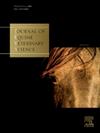Behavioral and physiological responses of horses at the Costa Rican National Horse Parade: Developing welfare indicators for real-time assessment
IF 1.3
3区 农林科学
Q2 VETERINARY SCIENCES
引用次数: 0
Abstract
The Costa Rican National Horse Parade is an annual cultural equestrian event involving approximately 2,000 horses. To address growing welfare concerns, this study evaluated behavioral and physiological indicators of stress in participating horses. Behavioral data were collected using an ethogram at 3 observation stations (start, middle, and end) along the 3.5-km route. During the 6.5-h event, 24 trained observers conducted one-minute evaluations of randomly selected horses (n = 557). Stress-related behaviors, including ear position, neck hyperflexion, and head tossing, were recorded, along with rider behaviors (e.g., excessive whip use and aggressive riding). Eye wrinkle depth (EWD; none, soft, deep) and eye white visibility (EWV; visible, nonvisible) were assessed in 346 horses using photographs. Physiological indicators were measured in 10 horses (5–15 years old) from the same facility, including body weight (BW), body condition score (BCS), and cortisol levels (blood and fecal). Blood cortisol (BC) levels were measured on farm at rest and 5 min post-exercise, 21 d pre-event, and immediately post-event. Fecal cortisol (FC) samples were collected at rest (21 d pre-event) and 16 h post-event. A chi-squared test was used to assess differences in behavioral stress indicators and observation stations (P < 0.05) and also to evaluate EWD and EWV across stations (P < 0.05). BC data were not normally distributed (P < 0.05), leading to the use of a Kruskal-Wallis test. FC concentrations were analyzed using a paired t-test. Statistical analyses were conducted using Jamovi (v2.3.28) and RStudio (v4.2.3). Significant differences (P < 0.05) were found among observation stations. Stress-related behaviors increased at the end station, coinciding with heightened aggressive rider behavior and excessive whip use. EDW and EWV assessments showed that deep EWD (44.23%) and EWV (40.38%) peaked at the middle station. Physiological assessments showed a 6 kg decrease in BW and a 0.02-point reduction in BCS, though these changes were not statistically significant (P > 0.05). Differences in BC levels (rest: 13.27 ng/mL, post-exercise: 20.19 ng/mL, post-event: 40.71 ng/mL; P < 0.05) were found, with post hoc Mann-Whitney U tests confirming significance for all comparisons (P ≤ 0.011). FC concentrations doubled post-event (mean rest: 11.10 ng/mL, post-event: 27.09 ng/mL, P = 0.0008). These findings indicate increased physiological and behavioral distress, highlighting the need for improved welfare protocols during the event.
哥斯达黎加国家马游行中马的行为和生理反应:为实时评估制定福利指标
哥斯达黎加国家马术游行是一年一度的文化马术活动,约有2000匹马参加。为了解决日益增长的福利问题,本研究评估了参与研究的马的行为和生理指标。在3.5 km路线上的3个观测站(起点、中间和终点)采用直方图收集行为数据。在6.5小时的活动中,24名训练有素的观察员对随机选择的马匹进行了一分钟的评估(n = 557)。与压力相关的行为,包括耳朵位置、颈部过度弯曲和头部晃动,以及骑手行为(例如,过度使用鞭子和攻击性骑乘)都被记录下来。眼部皱纹深度(EWD;无,软,深)和眼白色能见度(EWV;通过照片对346匹马进行了可见和不可见的评估。对来自同一设施的10匹马(5-15岁)进行生理指标测量,包括体重(BW)、身体状况评分(BCS)和皮质醇水平(血液和粪便)。在农场休息、运动后5分钟、活动前21天和活动后立即测量血液皮质醇(BC)水平。在休息时(事件前21 d)和事件后16 h收集粪便皮质醇(FC)样本。采用卡方检验评估行为应激指标和观察站的差异(P <;0.05),并评估跨站EWD和EWV (P <;0.05)。BC数据非正态分布(P <;0.05),导致使用Kruskal-Wallis检验。FC浓度分析采用配对t检验。使用Jamovi (v2.3.28)和RStudio (v4.2.3)进行统计分析。显著差异(P <;0.05)。与压力相关的行为在终点站有所增加,同时骑手的攻击性行为和鞭子的过度使用也有所增加。EDW和EWV评价结果显示,深层EDW(44.23%)和EWV(40.38%)在中站达到峰值。生理评估显示体重下降6公斤,BCS下降0.02点,尽管这些变化没有统计学意义(P >;0.05)。BC水平差异(休息:13.27 ng/mL,运动后:20.19 ng/mL,活动后:40.71 ng/mL;P & lt;经事后Mann-Whitney U检验证实,所有比较均具有显著性(P≤0.011)。事件发生后FC浓度翻倍(平均休息时间:11.10 ng/mL,事件发生后:27.09 ng/mL, P = 0.0008)。这些发现表明生理和行为上的痛苦增加,强调了在活动期间改善福利协议的必要性。
本文章由计算机程序翻译,如有差异,请以英文原文为准。
求助全文
约1分钟内获得全文
求助全文
来源期刊

Journal of Equine Veterinary Science
农林科学-兽医学
CiteScore
2.70
自引率
7.70%
发文量
249
审稿时长
77 days
期刊介绍:
Journal of Equine Veterinary Science (JEVS) is an international publication designed for the practicing equine veterinarian, equine researcher, and other equine health care specialist. Published monthly, each issue of JEVS includes original research, reviews, case reports, short communications, and clinical techniques from leaders in the equine veterinary field, covering such topics as laminitis, reproduction, infectious disease, parasitology, behavior, podology, internal medicine, surgery and nutrition.
 求助内容:
求助内容: 应助结果提醒方式:
应助结果提醒方式:


